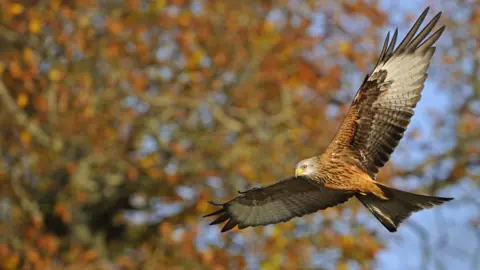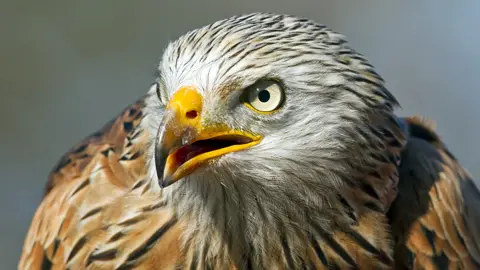UK red kite success story sees chicks sent to Spain
 Science Photo Library
Science Photo LibraryBritish-born red kites are being flown abroad in a mission to help rescue the dwindling Spanish population.
The birds of prey are threatened in parts of Spain by factors including poisoning and a lack of food.
Experts have been given special permission to take 30 red kites from England and release them in the remote mountains of south western Spain.
It's hoped the birds will thrive and breed there, rescuing the population.
In the UK, the red kite has had a remarkable turnaround after almost being wiped out.
A reintroduction programme in the 1980s and 1990s proved so successful that the population is now considered stable enough to support this vital conservation work.
 Defra
DefraDr Ian Evans of Natural England went out to Spain in the 1990s to collect wild red kites for release in the Chiltern Hills. He said the ones returning this week may be of Spanish descent.
"Those birds we took from Spain in the '90s have done really well in Britain - we're talking 4,000-plus pairs in the UK now, which is an incredible success story," he told BBC News.
In the 1990s, red kites in Spain were doing well in comparison to the UK, where years of human persecution, including egg collecting, poisoning and shooting, had pushed the bird to near extinction.
While red kites in the UK have since boomed, populations in some parts of southern Spain have gone the other way due to a number of factors.
Dr Evans said the reason to take the birds back to Spain and release them in the wild was to "secure the future of kites globally".
This week 15 red kites are being flown to Madrid to be released in Extremadura and Andalusia.
The juveniles are only a few weeks old, but already have most of their feathers and can feed independently.
About the red kite
- The red kite is one of Britain's largest birds of prey, known for its reddish-brown body, long wings, forked tail and distinctive "mewing" calls.
- Once considered a threat to game birds and domestic animals like cats and dogs, the red kite was hunted close to extinction in the UK and at one point there were just a few breeding pairs in central Wales.
- Red kites are largely scavengers, feeding on carrion and small prey such as rabbits.
A first batch of 15 birds has already been flown out, with the project kept under wraps until now.
The birds will perfect their flight in aviaries before being released fitted with the latest technology for monitoring how they adapt to their new habitat.
 Getty Images
Getty ImagesThe RSPB's Duncan Orr-Ewing said 30 birds will be released this year, with plans to release 30 more birds in each of the next two years.
"You need to find 90 to 100 birds to create a sustainable population in a given area," he said. "That should be sufficient to create a new breeding nucleus of the birds."
Red kites are found across Europe and numbers have increased overall in recent years, although there are still drastic declines in southern Spain, Portugal, and locally in Germany. The UK is now home to more than 10% of the world population of red kites.
The birds being sent to Spain hail from forests in Northamptonshire. Karl Ivans, wildlife ranger manager for Forestry England, which cares for the woodlands, was involved in the original efforts to rescue British red kites.
"It's a great honour to have been involved in the project right from the start," he said. "You feel really proud to do something good for the environment and for such a marvellous species."
The project brings together a number of conservation groups, including the RSPB, Forestry England, Natural England, Roy Dennis Wildlife Foundation and Accion por el Mundo Salvaje (Amus) in Spain.
Follow Helen on Twitter.
